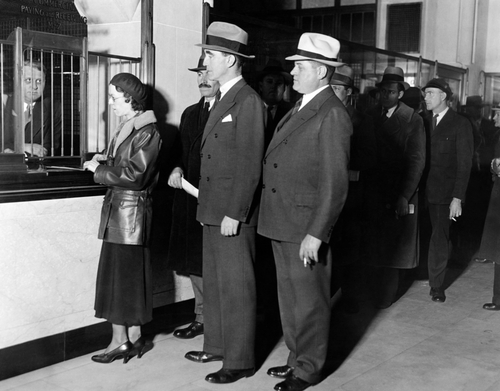Images from the past tell a story – and often present a lesson to be learned. Bank tellers are disappearing – fast. When ATMs first came out, they were a tremendous advancement in convenience. In more recent times, bank teller numbers have dwindled; not to be replaced entirely by the ATM, rather, they have morphed into product salespeople for the banks, more often than not sitting behind a desk and not behind prison-like bars that previously housed them.
Banks have been on the front foot ahead of technology, closing branches, moving to mobile deposits and online banking across virtually every sphere of their banking services. The core business of banking is the same but how they run their business bears no resemblance at all to the picture above.
Accounting professionals and bookkeepers face the same challenges: they need to change their approach to how they run their business. If anything technology is impacting even faster and impacting harder and deeper than on the banks.
We’re moving faster than ever, so I doubt we have as much time as tellers did to reconfigure the business case for the new breed of business owners (many of whom have never met a teller!).
Old versus New
Some things however never change. Tracking down missing receipts, finding bank statements, keeping track of multiple credit cards, separating personal and business purchases are always going to be part of the job of a bookkeeper but so too is the job of ensuring that as much of this drudge work is done automatically.
The disconnect is that the traditional bookkeeper has two major challenges. If she is doing the bookkeeping on-site, picking up paperwork (or receiving snail mail) from her clients, entering it into the books each month, and charging by the hour, the threat is that she stays as the ‘teller’ and bears witness to a downward spiral in her (hourly) fees.
The time-for- money race to the bottom
Ever since the billable hour business model came in, we lost sight of value. We tend to think in terms of time, and hours and that’s not how the customer thinks as they want to see results and/or value.
Accounting professionals and bookkeepers who embrace technology both in their own practice and with their clients are able to streamline internal bookkeeping workflow to get more done in less time.
The big switch
Just as the big switch in old-fashioned banking to a new business case involved both a technology interface (the ATM, the internet) and a re-purposing of the way they conduct business, so too can bookkeepers make the switch. We have more banking today than ever because banks offer more services (mortgages, insurance, financial planning, superannuation and so on). So there is an upside in the switch for both sides.
A switch to flat fee or value pricing is mandatory so that you don’t become obsolete like the traditional bank teller. The switch is really about moving away from selling your time to packaging your services in such a way as to be able to offer outcomes that enhance the client’s profit and cash flow while at the same time, differentiating your services from the competition. It’s also an opportunity to position your practice for premium level fees.

